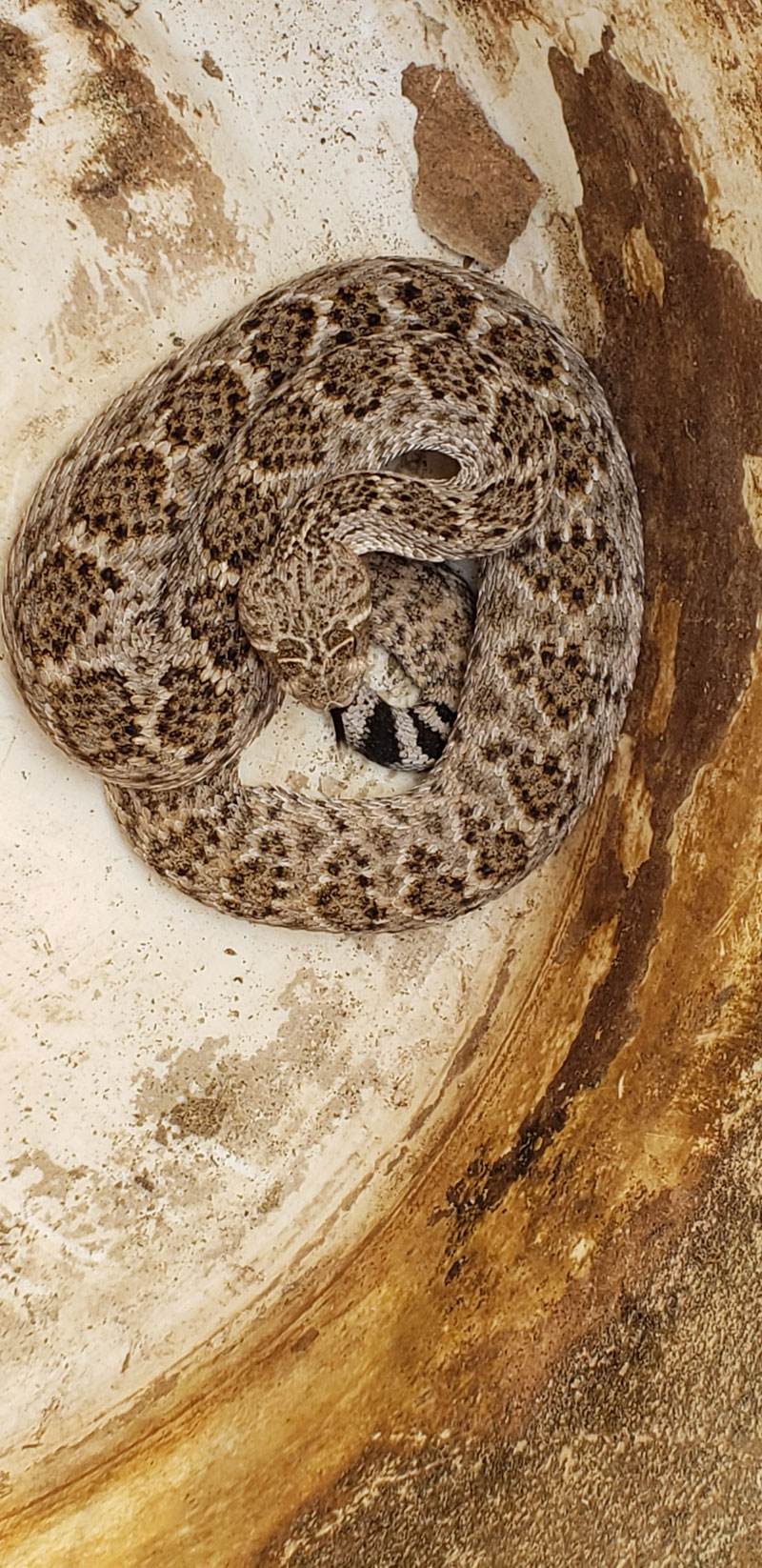Photo of a young rattlesnake (Crotalus atrox), the sixth we’ve found so far in 2019.
It’s officially Fall, and on October 1st we caught our sixth Western Diamondback Rattlesnake (Crotalus atrox) of 2019. The first rattlesnake this year was found March 27th, a month earlier than ever before. Here’s a link to a blog about that event:
https://goliadfarms.com/official-start-of-summer-on-the-farm/
I also blogged about the third rattlesnake of the year. Here’s that link:
https://goliadfarms.com/its-going-to-be-a-busy-rattlesnake-year/
During 2019 so far, we’ve had the usual sightings of dozens of copperheads (Agkistrodon contortrix laticinctus), one as late as last week. And, about a month ago a coral snake (Micrurus tener) was found next to our delivery van near the warehouse. We usually ignore the copperheads and coral snakes even when found in our yard since they are not aggressive. Also, copperheads have a weak venom and often administer dry bites. And, coral snakes don’t have hypodermic-type fangs so they don’t deliver venom unless they can chew on you a bit. Western Diamondbacks, on the other hand, can be nasty tempered and have an in-your-face attitude. So, if they are in the yard close to the house or near the greenhouses, we relocate them to one of our pastures where there is an ample supply of mice, gopher, and wood rats for them to eat.
This sixth rattlesnake was discovered after dark. Susie (wife and business manager) and I had returned from town about dusk. The dogs, German Shepherds Oso and Maya, and rescue mutt Sunshine, convinced us they needed an outdoor excursion. Oso and Maya don’t look kindly upon us going to town without taking them and Sunshine, who won’t get in a car, doesn’t think we should ever leave the farm, so they were insistent on a walk. Since the warehouse needed to be closed up and the greenhouses checked, we decided to combine those things with a walk that just might satisfy the dogs. By the time we changed into non-town clothes it was dark. Susie grabbed a flashlight and asked if I wanted one. I said no since I have good night vision and could rely on Susie to light the way.
As we approached the warehouse and greenhouses, I turned to Susie who was a few yards back and said, “Good thing the dogs are clearing the way.” I was thinking they’d find any snakes, particularly rattlesnakes, and warn me. The three dogs trotted along the path alongside the warehouse and turned on the walkway that runs in front of the three greenhouses. I followed.
As we reached the far greenhouse Susie, still behind, called out, “Rattlesnake!” I scoffed, but went back to look. Sure ‘nuff, just at the turn sat a perfectly still and coiled rattlesnake not more than two feet from where the dogs and I had trod. None of the dogs had seen or smelled it. The dogs walked up behind me to see what I’d found. I warned the dogs with, “Snake!” They know that word. The dogs then quickly found the snake and just as quickly discerned it was a poisonous snake. They swiftly attack any non-venomous snakes, but studiously avoid approaching poisonous ones.
Susie and the dogs watched the snake, which remained calmly coiled on the walk, while I went into the warehouse to get a snake stick (I’m not allowed to hand catch poisonous snakes since the 2004 event…don’t ask). I found one but it was defective. We gathered up the dogs and went back to the house to get a good stick. I didn’t expect the snake to remain where it was, but hoped it would.
Returning to where the snake had been, I was surprised it was still coiled and waiting. I snatched it with the snake stick. The snake, having been quiet to this point, finally rattled. I dropped it in a nearby 55-gallon white plastic barrel for the night.
The next day I photographed the snake in the barrel and Oso, Maya, and I took it to our east pasture for relocation. The rattlesnake, a young male I think, rattled all the way. I unceremoniously dumped it out of the barrel, expecting it to coil and rattle. Most Western Diamondbacks are very aggressive and stand their ground. But he sped away into some brush, moving at speed I’d only seen in snakes like Eastern Yellow-Bellied Racers (Coluber constrictor flaviventris) and Coachwhips (Masticophis flagellum testaceus), both of which reside on the Farm. I was happy he raced away from me instead of at me. Fortunately, he headed for some brush. I learned long ago not to get between a rattlesnake caught in the open and shelter. It will go through you to get to the shelter.
Earlier this year, I had written, “Judging from the early poisonous snake sightings, we’re in for a long summer.” That turned out to be correct, both in terms of snakes and temperature. It’s October and we are still sighting poisonous snakes and the daily high temperatures are above 95°F (35°C).


Leave a Reply